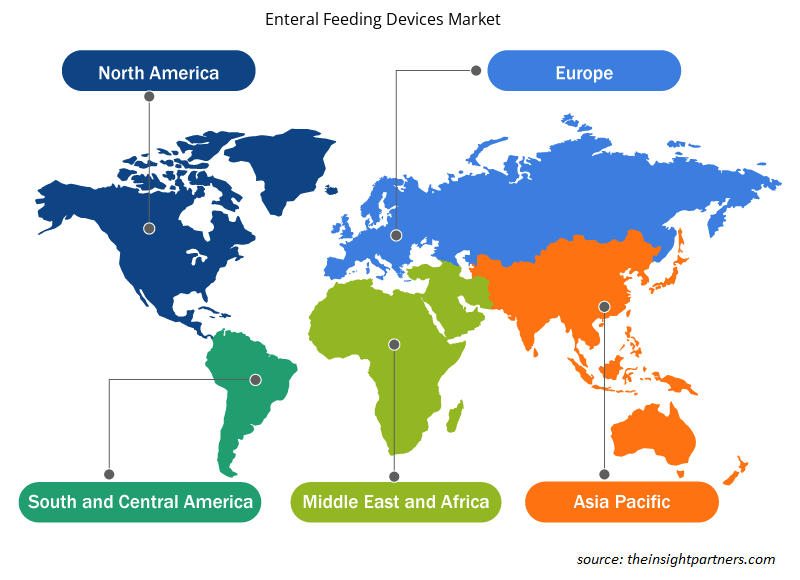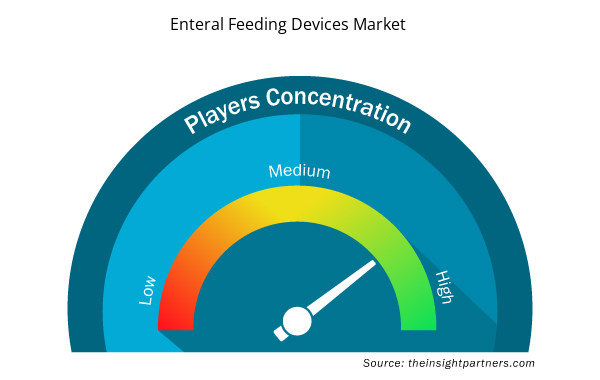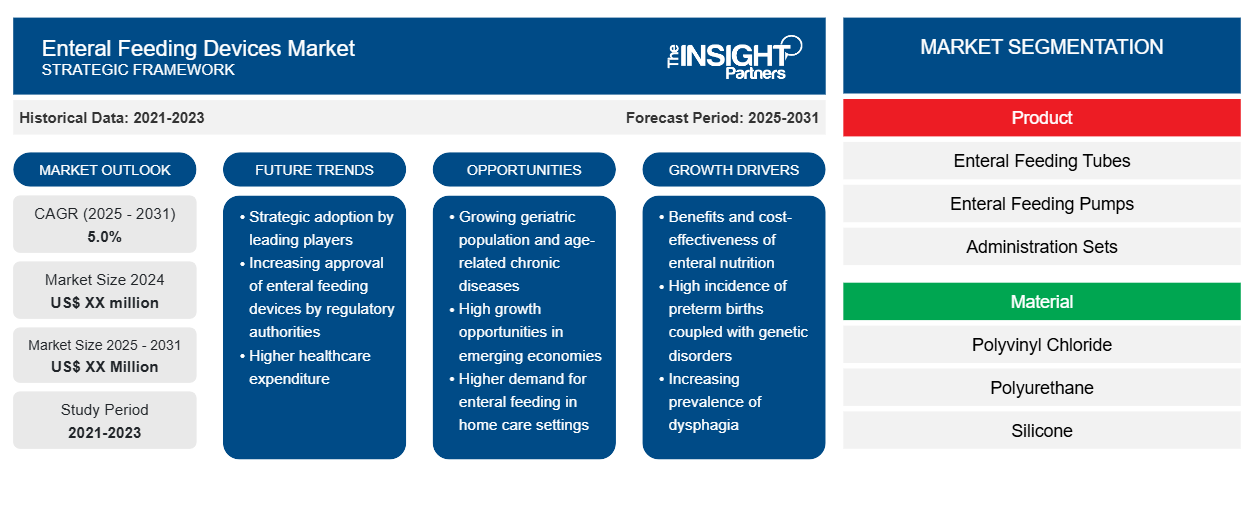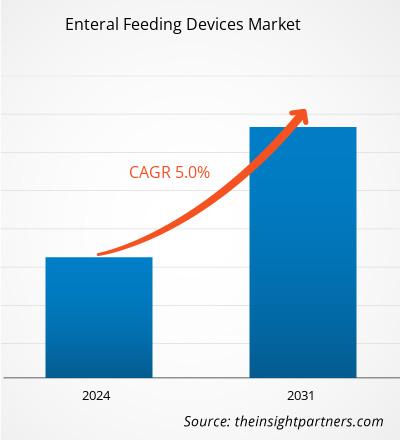Le marché des dispositifs d'alimentation entérale devrait enregistrer un TCAC de 5,0 % de 2023 à 2031, avec une taille de marché passant de XX millions USD en 2023 à XX millions USD d'ici 2031.
Le rapport est segmenté par type de dispositifs d'alimentation entérale (troubles anxieux, troubles liés à la toxicomanie, troubles de l'humeur, autres). Le rapport présente en outre une analyse basée sur le matériau [chlorure de polyvinyle (PVC), polyuréthane et silicone]. Sur la base du groupe d'âge (pédiatrie et adultes). Sur la base de l'application (oncologie, maladies gastro-intestinales, troubles neurologiques, diabète, hypermétabolisme et autres applications). Sur la base de l'utilisateur final (hôpitaux, centre de chirurgie ambulatoire et soins à domicile). L'analyse globale est ensuite décomposée au niveau régional et par principaux pays. Le rapport offre la valeur en USD pour l'analyse et les segments ci-dessus.
Objectif du rapport
Le rapport sur le marché des dispositifs d'alimentation entérale de The Insight Partners vise à décrire le paysage actuel et la croissance future, les principaux facteurs moteurs, les défis et les opportunités. Cela fournira des informations à diverses parties prenantes commerciales, telles que :
- Fournisseurs/fabricants de technologie : pour comprendre l’évolution de la dynamique du marché et connaître les opportunités de croissance potentielles, leur permettant de prendre des décisions stratégiques éclairées.
- Investisseurs : Effectuer une analyse complète des tendances concernant le taux de croissance du marché, les projections financières du marché et les opportunités qui existent tout au long de la chaîne de valeur.
- Organismes de réglementation : Réglementer les politiques et surveiller les activités du marché dans le but de minimiser les abus, de préserver la confiance des investisseurs et de maintenir l’intégrité et la stabilité du marché.
Segmentation du marché des dispositifs d'alimentation entérale
Produit
- Sondes d'alimentation entérale
- Pompes d'alimentation entérale
- Ensembles d'administration
- Seringues entérales
- Consommables
Matériel
- Chlorure de polyvinyle
- Polyuréthane
- Silicone
Groupe d'âge
- Pédiatrie
- Adultes
Application
- Oncologie
- Maladies gastro-intestinales
- Troubles neurologiques
- Diabète
- Hypermétabolisme
- Autres applications
Application
- Oncologie
- Maladies gastro-intestinales
- Troubles neurologiques
- Diabète
- Hypermétabolisme
- Autres applications
Personnalisez ce rapport en fonction de vos besoins
Vous bénéficierez d'une personnalisation gratuite de n'importe quel rapport, y compris de certaines parties de ce rapport, d'une analyse au niveau des pays, d'un pack de données Excel, ainsi que d'offres et de remises exceptionnelles pour les start-ups et les universités.
- Obtenez les principales tendances clés du marché de ce rapport.Cet échantillon GRATUIT comprendra une analyse de données, allant des tendances du marché aux estimations et prévisions.
Facteurs de croissance du marché des dispositifs d'alimentation entérale
- Avantages et rentabilité de la nutrition entérale : Il s'agit d'apporter des nutriments directement dans le tube digestif aux patients qui ne peuvent pas consommer et absorber les nutriments par voie orale. La croissance des marchés de la nutrition entérale a été attribuée à de multiples avantages et facteurs de rentabilité. La nutrition entérale présente de meilleurs taux de guérison chez les patients souffrant de maladies chroniques ou hospitalisés lorsque leur état nutritionnel est maintenu, voire amélioré.
- Forte incidence de naissances prématurées et de maladies génétiques : Le nombre croissant d'accouchements prématurés et de maladies génétiques chez les patients pédiatriques et néonatals exige une nutrition entérale de plus en plus importante. En raison de leur faible poids à la naissance, ces bébés prématurés ont des besoins nutritionnels plus élevés en raison de leurs systèmes organiques moins développés. Il faut donc répondre à leurs besoins en utilisant l'alimentation entérale de manière appropriée. Pour les enfants atteints de maladies génétiques qui interfèrent avec la digestion et l'absorption, l'alimentation entérale peut fournir une forme de nutrition meilleure et plus digeste tout en garantissant leur apport en nutriments de base.
- Augmentation de la prévalence de la dysphagie : la dysphagie est beaucoup plus fréquente chez les personnes âgées, principalement en raison de pathologies liées à l'âge, notamment les accidents vasculaires cérébraux, les maladies neurologiques et la faiblesse musculaire. C'est cette population vieillissante qui fait grimper en flèche la demande de solutions de nutrition entérale. Même la maladie de Parkinson, la sclérose en plaques et la sclérose latérale amyotrophique (SLA) entraînent généralement une dysphagie, qui nécessite une thérapie nutritionnelle par EN. Stimulant ainsi la croissance du marché
Tendances futures du marché des dispositifs d'alimentation entérale
- Adoption stratégique par les principaux acteurs : les entreprises continuent de développer des produits de nutrition entérale spécifiques destinés à des pathologies particulières, comme les maladies rénales et diabétiques, ainsi qu'aux besoins liés à l'oncologie. Les améliorations apportées aux sondes d'alimentation et aux dispositifs d'administration facilitent considérablement leur utilisation et améliorent le confort des patients, avec en plus la possibilité de les utiliser à domicile.
- Approbation croissante des dispositifs d'alimentation entérale par les autorités réglementaires : L'approbation réglementaire doit être accordée aux dispositifs d'alimentation entérale car la demande d'un soutien nutritionnel sûr et approprié augmente de manière importante sur le terrain, en particulier dans de nombreux domaines - dans les soins à domicile. Les autorités réglementaires approuvent de plus en plus des technologies d'alimentation innovantes qui aident à obtenir de meilleurs résultats pour les patients avec des approbations plus rapides accordées pour une sécurité, une facilité d'utilisation et une efficacité améliorées des dispositifs. La tendance des autorités réglementaires à approuver les dispositifs d'alimentation entérale est l'une des principales tendances du marché de la nutrition entérale.
- Augmentation des dépenses de santé : à mesure que la nutrition entérale est de plus en plus utilisée dans les établissements de santé dans le cadre du traitement de routine de nombreuses maladies, les dépenses en produits et services associés à la nutrition entérale augmentent. L'augmentation des dépenses de santé est une autre tendance sérieuse à laquelle le marché est confronté, une fois encore, un effet domino des changements économiques et des objectifs de soins de santé.
Opportunités de marché pour les dispositifs d'alimentation entérale
- Croissance de la population gériatrique et maladies chroniques liées à l'âge : les personnes âgées sont confrontées à des problèmes tels qu'une diminution de l'appétit, des troubles de la déglutition (dysphagie) et une malabsorption, ce qui rend difficile pour elles de maintenir une alimentation appropriée. La croissance rapide de la population gériatrique et l'augmentation du nombre de maladies chroniques liées à l'âge et à la gériatrie créeront de vastes opportunités sur le marché de la nutrition entérale
- De fortes opportunités de croissance dans les économies émergentes : les soins de santé et les prestations de santé évoluent dans un contexte de vieillissement de la population. La nutrition est de plus en plus reconnue comme partie intégrante des soins holistiques et un nombre croissant d'utilisateurs de nutrition entérale. La croissance rapide de la population gériatrique et la prévalence des maladies chroniques liées à l'âge offrent de fortes opportunités pour le marché de la nutrition entérale. Le marché continuera de se développer et prendra forme grâce à l'innovation visant à améliorer la santé des personnes âgées dans les économies en développement en répondant spécifiquement aux besoins nutritionnels de cette population cible.
- Demande accrue de nutrition entérale dans les contextes de soins à domicile : les préférences des patients et de leur famille en matière de soins à domicile découlent du confort, de la familiarité et de l'environnement personnalisé que procure l'alimentation entérale, qui permettrait de poursuivre la nutrition sans visites fréquentes à l'hôpital. L'augmentation des droits à l'alimentation entérale dans les soins à domicile constitue une opportunité considérable pour le marché de la nutrition entérale.
Aperçu régional du marché des dispositifs d'alimentation entérale
Les tendances et facteurs régionaux influençant le marché des dispositifs d’alimentation entérale tout au long de la période de prévision ont été expliqués en détail par les analystes d’Insight Partners. Cette section traite également des segments et de la géographie du marché des dispositifs d’alimentation entérale en Amérique du Nord, en Europe, en Asie-Pacifique, au Moyen-Orient et en Afrique, ainsi qu’en Amérique du Sud et en Amérique centrale.

- Obtenez les données régionales spécifiques au marché des dispositifs d'alimentation entérale
Portée du rapport sur le marché des dispositifs d'alimentation entérale
| Attribut de rapport | Détails |
|---|---|
| Taille du marché en 2023 | XX millions de dollars américains |
| Taille du marché d'ici 2031 | XX millions de dollars américains |
| Taux de croissance annuel composé mondial (2023-2031) | 5,0% |
| Données historiques | 2021-2022 |
| Période de prévision | 2024-2031 |
| Segments couverts | Par produit
|
| Régions et pays couverts | Amérique du Nord
|
| Leaders du marché et profils d'entreprises clés |
|
Densité des acteurs du marché des dispositifs d'alimentation entérale : comprendre son impact sur la dynamique commerciale
Le marché des dispositifs d'alimentation entérale connaît une croissance rapide, tirée par la demande croissante des utilisateurs finaux en raison de facteurs tels que l'évolution des préférences des consommateurs, les avancées technologiques et une plus grande sensibilisation aux avantages du produit. À mesure que la demande augmente, les entreprises élargissent leurs offres, innovent pour répondre aux besoins des consommateurs et capitalisent sur les tendances émergentes, ce qui alimente davantage la croissance du marché.
La densité des acteurs du marché fait référence à la répartition des entreprises ou des sociétés opérant sur un marché ou un secteur particulier. Elle indique le nombre de concurrents (acteurs du marché) présents sur un marché donné par rapport à sa taille ou à sa valeur marchande totale.
Les principales entreprises opérant sur le marché des dispositifs d'alimentation entérale sont :
- Abbott
- B. Braun Melsungen AG
- Société scientifique de Boston
- SANTÉ CARDINALE
- Cook Médical LLC
Avis de non-responsabilité : les sociétés répertoriées ci-dessus ne sont pas classées dans un ordre particulier.

- Obtenez un aperçu des principaux acteurs du marché des dispositifs d'alimentation entérale
Principaux arguments de vente
- Couverture complète : Le rapport couvre de manière exhaustive l’analyse des produits, des services, des types et des utilisateurs finaux du marché des dispositifs d’alimentation entérale, offrant un paysage holistique.
- Analyse d’experts : Le rapport est compilé sur la base d’une compréhension approfondie des experts et analystes du secteur.
- Informations à jour : Le rapport garantit la pertinence commerciale en raison de sa couverture des informations récentes et des tendances des données.
- Options de personnalisation : ce rapport peut être personnalisé pour répondre aux exigences spécifiques du client et s'adapter parfaitement aux stratégies commerciales.
Le rapport de recherche sur le marché des dispositifs d’alimentation entérale peut donc aider à ouvrir la voie au décodage et à la compréhension du scénario de l’industrie et des perspectives de croissance. Bien qu’il puisse y avoir quelques préoccupations valables, les avantages globaux de ce rapport ont tendance à l’emporter sur les inconvénients.
- Analyse historique (2 ans), année de base, prévision (7 ans) avec TCAC
- Analyse PEST et SWO
- Taille du marché Valeur / Volume - Mondial, Régional, Pays
- Industrie et paysage concurrentiel
- Ensemble de données Excel


- Third Party Logistics Market
- Industrial Valves Market
- Hydrogen Compressors Market
- Compounding Pharmacies Market
- Single-Use Negative Pressure Wound Therapy Devices Market
- Sexual Wellness Market
- Adaptive Traffic Control System Market
- Joint Pain Injection Market
- Intradermal Injection Market
- Artificial Intelligence in Healthcare Diagnosis Market

Report Coverage
Revenue forecast, Company Analysis, Industry landscape, Growth factors, and Trends

Segment Covered
This text is related
to segments covered.

Regional Scope
North America, Europe, Asia Pacific, Middle East & Africa, South & Central America

Country Scope
This text is related
to country scope.
Questions fréquemment posées
The Enteral Feeding Devices Market is estimated to witness a CAGR of 5.0% from 2023 to 2031
North America region accounted for the largest enteral feeding devices market share
Lack of awareness among the medical society about enteral feeding devices s the major challenges in the enteral feeding devices market
2021 to 2022- are the historic year, 2023 - base year, 2024 to 2031- are the forecast year
Abbott Nutrition, ALCOR Scientific, Applied Medical Technology e the key players in the enteral feeding devices market
China, Japan, and India are the major Asia Pacific countries contributing in the enteral feeding devices market
Trends and growth analysis reports related to Life Sciences : READ MORE..
The List of Companies - Enteral Feeding Devices Market
- Abbott
- B. Braun Melsungen AG
- Boston Scientific Corporation
- CARDINAL HEALTH
- Cook Medical LLC
- Danone SA
- Fresenius Kabi AG
- Moog Inc
- Nestlé
- Owens & Minor, Inc.
The Insight Partners performs research in 4 major stages: Data Collection & Secondary Research, Primary Research, Data Analysis and Data Triangulation & Final Review.
- Data Collection and Secondary Research:
As a market research and consulting firm operating from a decade, we have published and advised several client across the globe. First step for any study will start with an assessment of currently available data and insights from existing reports. Further, historical and current market information is collected from Investor Presentations, Annual Reports, SEC Filings, etc., and other information related to company’s performance and market positioning are gathered from Paid Databases (Factiva, Hoovers, and Reuters) and various other publications available in public domain.
Several associations trade associates, technical forums, institutes, societies and organization are accessed to gain technical as well as market related insights through their publications such as research papers, blogs and press releases related to the studies are referred to get cues about the market. Further, white papers, journals, magazines, and other news articles published in last 3 years are scrutinized and analyzed to understand the current market trends.
- Primary Research:
The primarily interview analysis comprise of data obtained from industry participants interview and answers to survey questions gathered by in-house primary team.
For primary research, interviews are conducted with industry experts/CEOs/Marketing Managers/VPs/Subject Matter Experts from both demand and supply side to get a 360-degree view of the market. The primary team conducts several interviews based on the complexity of the markets to understand the various market trends and dynamics which makes research more credible and precise.
A typical research interview fulfils the following functions:
- Provides first-hand information on the market size, market trends, growth trends, competitive landscape, and outlook
- Validates and strengthens in-house secondary research findings
- Develops the analysis team’s expertise and market understanding
Primary research involves email interactions and telephone interviews for each market, category, segment, and sub-segment across geographies. The participants who typically take part in such a process include, but are not limited to:
- Industry participants: VPs, business development managers, market intelligence managers and national sales managers
- Outside experts: Valuation experts, research analysts and key opinion leaders specializing in the electronics and semiconductor industry.
Below is the breakup of our primary respondents by company, designation, and region:

Once we receive the confirmation from primary research sources or primary respondents, we finalize the base year market estimation and forecast the data as per the macroeconomic and microeconomic factors assessed during data collection.
- Data Analysis:
Once data is validated through both secondary as well as primary respondents, we finalize the market estimations by hypothesis formulation and factor analysis at regional and country level.
- Macro-Economic Factor Analysis:
We analyse macroeconomic indicators such the gross domestic product (GDP), increase in the demand for goods and services across industries, technological advancement, regional economic growth, governmental policies, the influence of COVID-19, PEST analysis, and other aspects. This analysis aids in setting benchmarks for various nations/regions and approximating market splits. Additionally, the general trend of the aforementioned components aid in determining the market's development possibilities.
- Country Level Data:
Various factors that are especially aligned to the country are taken into account to determine the market size for a certain area and country, including the presence of vendors, such as headquarters and offices, the country's GDP, demand patterns, and industry growth. To comprehend the market dynamics for the nation, a number of growth variables, inhibitors, application areas, and current market trends are researched. The aforementioned elements aid in determining the country's overall market's growth potential.
- Company Profile:
The “Table of Contents” is formulated by listing and analyzing more than 25 - 30 companies operating in the market ecosystem across geographies. However, we profile only 10 companies as a standard practice in our syndicate reports. These 10 companies comprise leading, emerging, and regional players. Nonetheless, our analysis is not restricted to the 10 listed companies, we also analyze other companies present in the market to develop a holistic view and understand the prevailing trends. The “Company Profiles” section in the report covers key facts, business description, products & services, financial information, SWOT analysis, and key developments. The financial information presented is extracted from the annual reports and official documents of the publicly listed companies. Upon collecting the information for the sections of respective companies, we verify them via various primary sources and then compile the data in respective company profiles. The company level information helps us in deriving the base number as well as in forecasting the market size.
- Developing Base Number:
Aggregation of sales statistics (2020-2022) and macro-economic factor, and other secondary and primary research insights are utilized to arrive at base number and related market shares for 2022. The data gaps are identified in this step and relevant market data is analyzed, collected from paid primary interviews or databases. On finalizing the base year market size, forecasts are developed on the basis of macro-economic, industry and market growth factors and company level analysis.
- Data Triangulation and Final Review:
The market findings and base year market size calculations are validated from supply as well as demand side. Demand side validations are based on macro-economic factor analysis and benchmarks for respective regions and countries. In case of supply side validations, revenues of major companies are estimated (in case not available) based on industry benchmark, approximate number of employees, product portfolio, and primary interviews revenues are gathered. Further revenue from target product/service segment is assessed to avoid overshooting of market statistics. In case of heavy deviations between supply and demand side values, all thes steps are repeated to achieve synchronization.
We follow an iterative model, wherein we share our research findings with Subject Matter Experts (SME’s) and Key Opinion Leaders (KOLs) until consensus view of the market is not formulated – this model negates any drastic deviation in the opinions of experts. Only validated and universally acceptable research findings are quoted in our reports.
We have important check points that we use to validate our research findings – which we call – data triangulation, where we validate the information, we generate from secondary sources with primary interviews and then we re-validate with our internal data bases and Subject matter experts. This comprehensive model enables us to deliver high quality, reliable data in shortest possible time.


 Obtenez un échantillon gratuit pour ce rapport
Obtenez un échantillon gratuit pour ce rapport